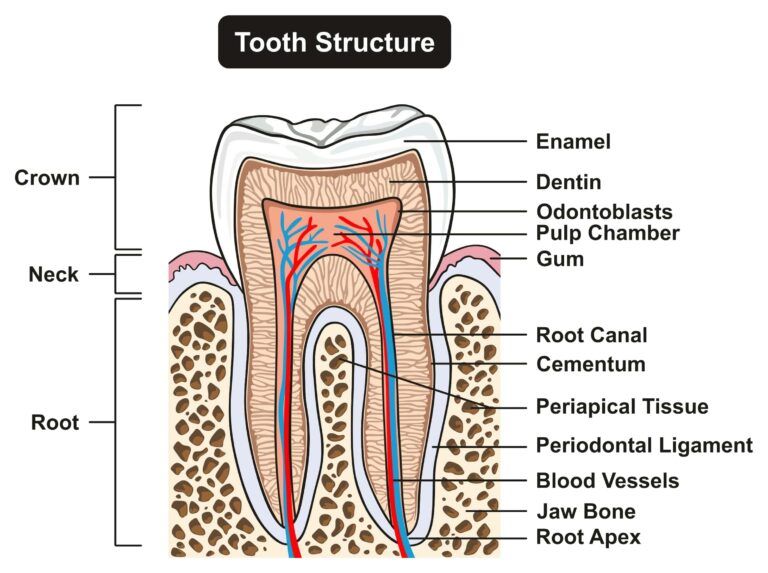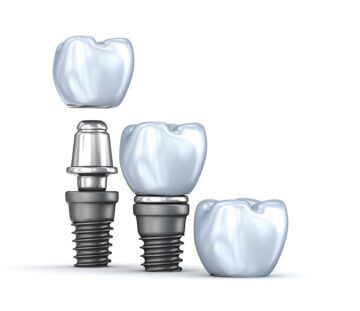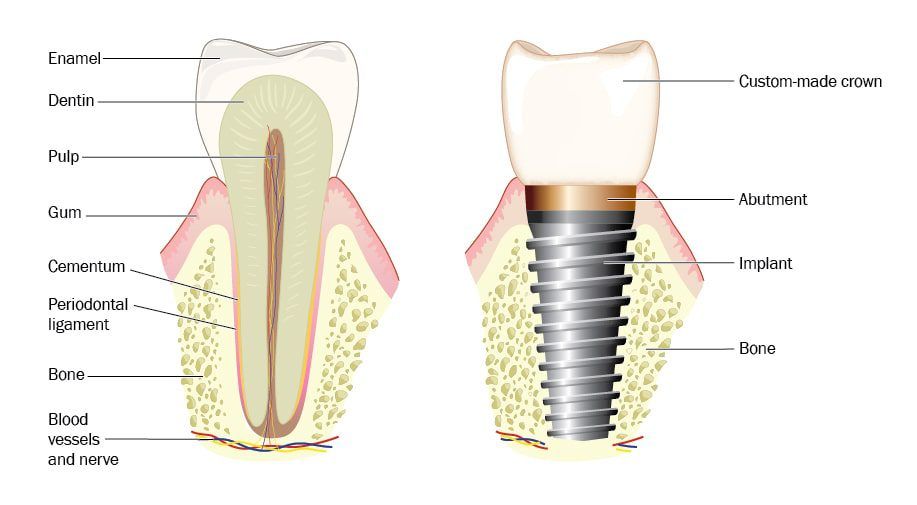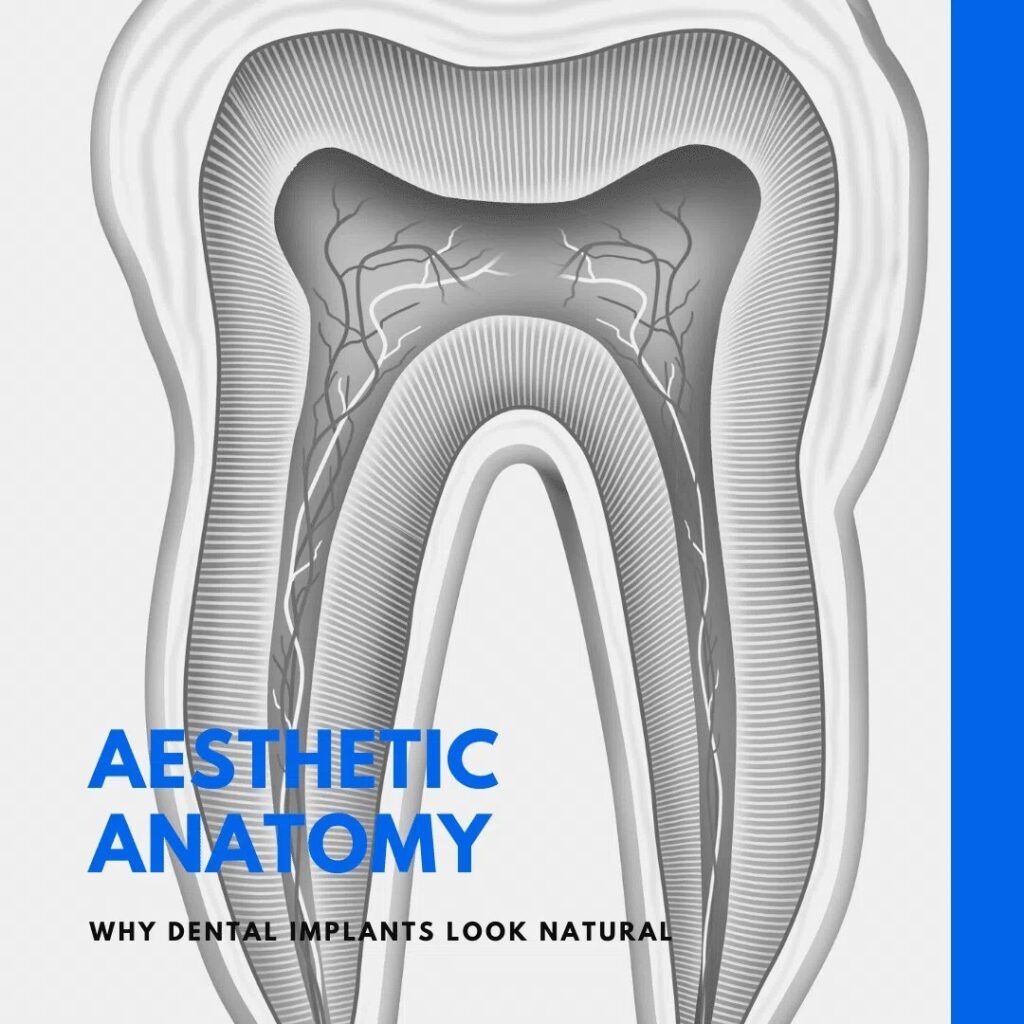Nowadays if you are looking for a way to replace missing teeth, dental implants are a common recommendation. You may not be able to tell by looking at them, but many people have dental implants. In fact, the American Academy of Implant Dentistry notes that as many as 3 million Americans have dental implants, with approximately 500,000 new implants being placed yearly. One reason for their growing popularity is because dental implants can provide a natural-looking tooth replacement and they are the best option for patients who need teeth restored following an injury or disease.
Out of the various tooth-replacement options, dental implants are considered the most aesthetic simply because they look the most like natural teeth. Since a lot of what we consider “aesthetic” is based upon the idea that dental restorations must look as natural as possible, let’s take a brief look at some basic tooth anatomy:
The Anatomy of a Natural Tooth
For starters, there are three layers that make up a single tooth. These include:
- Enamel: outermost layer is known as tooth enamel, and it is responsible for protecting the tooth from bacteria that can cause gum disease and tooth decay. As such, the enamel is the strongest substance in the human body and is even stronger than bone! With that being said, however, the enamel can still become damaged by decay-causing bacteria, as well as excessively acidic foods and beverages. Because of this, the tooth enamel tends to erode, or wear away, over time.
- Dentin: as the enamel wears away, the underlying dentin layer may begin to show. The dentin layer has a yellowish-color, which can make your teeth appear to be stained. Exposed dentin can also lead to tooth sensitivity, since it allows stimuli to enter the tooth.
- Pulp: the innermost layer of the tooth is known as the pulp layer and it is composed of blood vessels and the tooth’s nerve.

In addition to the three layers that make up a single tooth, there are different parts of the tooth, including:
- Crown: the crown is the portion of the tooth that is naturally visible above the gums. It is composed of enamel and dentin. Although most people think of their crown being their entire tooth, the crown only makes up one-third of the entire tooth structure.
- Neck: the neck is where the crown meets the root. The crown is covered in enamel, while the roots are covered in cementum, so the neck can also be considered the junction between enamel and cementum. In most cases, the neck is also covered by the gums, however it can be exposed when the gums recede.
- Root: the root is the part of the tooth that lies underneath the gums and in the jawbone. The inside of the tooth root contains the root canal, which is a passage that contains dental pulp, as well as nerves and blood vessels. The outside of the tooth root is protected by the cementum. The root also holds the tooth in place using the cementum and periodontal ligament. A tooth’s root makes up two-thirds of its entire structure.
The Anatomy of a Dental Implant
Now that we understand the basics of tooth anatomy, we can look at the way dental implants are structured. Each part of a dental implant plays an integral role in achieving a natural look, which is why dental implants are one of the best ways to replace missing teeth.
There are three main parts of a dental implant. These parts include:

- Titanium Implant: The titanium implant is the main body of the dental implant. It is a screw-shaped post with small divots near its top. Dental implants are made from high-grade titanium which features a very high strength to weight ratio and is one of the lightest metals on earth. Dental implants are generally inserted into the bone during surgery in two parts, although there are some shorter implants that can be inserted during a single procedure. Once inserted into the bone, they will only be visible with x-rays.
- Abutment: The abutment is a small, metal connector piece that screws into the implant. The abutment will stick out from underneath the gums in order to provide a post to cement the visible dental prosthesis. The abutment is only visible until the prothesis is cemented over the top.
- Dental prosthesis: the final part of a dental implant is the dental prosthesis, which is the only visible portion of an implant-supported restoration. Depending on your treatment plan, a dental crown, bridge, or denture may be used. One of these prosthesis will be cemented onto the abutment, which will allow it to be supported by the underlying implant.
How Anatomy Creates Aesthetics
When compared to other tooth-replacement options, dental implants are generally considered to be more aesthetic because of this structure. In fact, there are a few key parallels between the structure of a dental implant and the anatomy of a natural tooth. For example, the dental restoration (crown, bridge, or denture) functions as the crown, or visible portion of the tooth, while the abutment could be argued to function as the neck of the tooth.
Other tooth replacement options, such as traditional bridges and dentures, also contain artificial “crowns”. A dental bridge may contain one or more fake teeth used to mimic the appearance of the natural teeth, while a denture contains an entire arch of fake teeth. Nowadays, both bridges and dentures are fabricated to be highly aesthetic as well, however their structure only mimics the crown, which is only one-third of natural tooth anatomy.

The other two-thirds of a natural tooth is the tooth root. Since the titanium implant is placed into the jawbone so that it can fuse with the surrounding bone, it acts like a natural tooth root. Although they are not visible, the tooth roots play a few key roles. For starters, tooth roots are associated with chewing force. Because of this, dental implants can restore almost all of your natural chewing function. Although dental bridges and dentures can restore some of your natural chewing function, they cannot offer the same results simply because they lack the equivalent of a tooth root.
Not only do dental implants restore chewing function, but the implant also provides jawbone stimulation in the same way the natural tooth roots would. Every time you bite down, the tooth roots transfer the force to the jawbone. This constant, recurring force maintains bone mass, which also maintains your facial contour. When one or more teeth are lost, there are no longer roots that stimulate the jawbone. As a result, the body essentially takes bone mass from the jaw and dispenses it to other areas of the body. This causes the jawbone to deteriorate, which also changes your facial contour.
By mimicking the anatomy of natural teeth, dental implants also mimic the appearance of natural teeth. This makes them appear more aesthetic overall when compared to other tooth replacement options like traditional bridges or dentures. Additionally, the anatomy of dental implants also allows them to be more functional, which preserves natural chewing function, as well as the structural integrity of the jawbone over time. Overall, dental implants are the most aesthetic tooth replacement option in both the short and long term.

